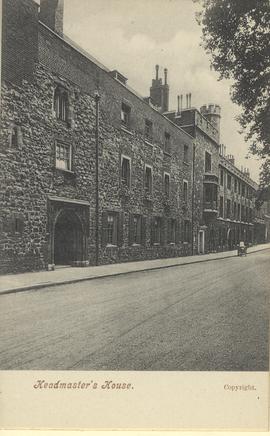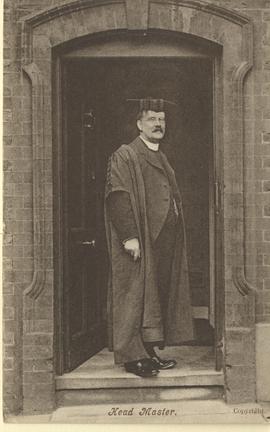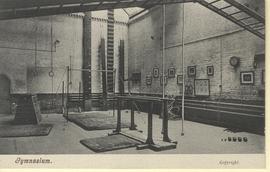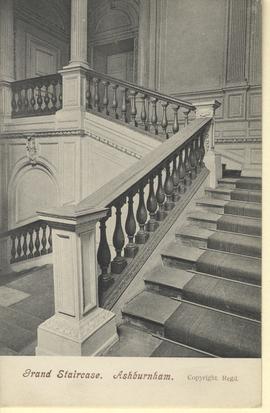One copy annotated on reverse by R.S. Chalk, as follows:
'Memories 1918-1924
In Dr Gow’s last year (1918-19) few boys had occasion to enter the HM’s house except for a Confirmation interview (as also under H.C.W.).
It was different when H.C.W. came in 1919. He and his wife set out to entertain all boarders to dinner, two by two. I recall going in fear and trembling with an even smaller Under School boy- and being much relieved by the kind welcome we received. Monitors and Senior K.SS were later invited from time to time.
While in charge of the School Coin Collection from c.1922 to 1924, I was allowed unlimited access to the landing where the Cabinet was kept. (This was a great privilege).
I have also happy recollections of private tuition classes in Theocritus conducted by the H.M. in evenings of Play 1923 and Lent 1924 for KSS in the VII. These played no small part in the Open Scholarships some of us gained at that time.'
One copy annotated on reverse by R.S. Chalk, as follows:
'1. Dr. JAMES GOW (‘Jimmy’), H.M. 1901-1919
My first meeting with him was at Challenge 1918. I owe him a lifelong debut for his accepting me without Common Entrance Exam (on the strength of my dismal Challenge papers), thus saving a second journey from my home in Devon in War-time conditions.
My first three Terms (Play 1918-Election 1919) coincided with his last three. He had been a great and good HM, but was now almost blind and moved in a dignified daze, piloting himself with a stick. (Intent on my prep, I once collided with him in Yard)
Through no fault of his, School discipline had become somewhat lax by 1918. Leave and Plays were easily given (e.g. to go skating on the Serpentine in Lent 1919).
He was much loved and his departure was a solemn occasion. He shook hands with every boy after his last Prayers. I am glad I remembered to say ‘Thank you, Sir’ – with the classical Remove form-prize in my hand.'
One copy annotated on reverse by R.S. Chalk, as follows:
'Memories 1918-1924
Gym was regarded as an honourable ‘occupat’ but attracted only a limited number of enthusiasts. Like the majority, I only saw the inside of Gym, on the occasion of annual inter-House contests. I have memories of D.B. (‘Spud’) Murphy, K.S., competing in (and I think retaining) the Championship only a few weeks after a very nearly fatal bout of pneumonia.
I also remember all boarders (and I think day-boys too) having to turn up in Gym for another purpose, turn by turn, during Lent 1920. The new HM (H.C.W.) had decreed that all the School should be weighed and measured (in the nude) in order to check-up on our avowedly poor physique in post-War years. We also had to blow three times down a tube into a machine which purported to register our “Vital Capacity”. I failed in this abjectly, and was accorded a life-span of about 25 years! Fortunately none of us took this gadget too seriously.'
One copy annotated on reverse by R.S. Chalk, as follows:
'1918-1924
Said my Substance (Tony Allpress) to me on my first day, “Pity they haven’y got a P.C. of Rigaud’s like that”. (It wd. not have made so good a picture as this severe but symmetrical structure). It says much for the rigid ‘isolationist’ House system of my time that I only once set foot inside GG in all my six years- and that very briefly for some very special purpose on the last day of Term.
R. Tanner (“The Buck”) was House Master of GG for my first three terms, Major D.P. Shaw for the remainder (1919 till his death from war-wounds in 1924). Grant’s and Rigaud’s were consistently on good terms (having much in common), but about 1922-4 GG developed into a decidedly ‘tough’ House, with a particular antipathy to K.SS (which was reciprocated). This nearly resulted in an ugly scene during Lamprobatics in 1923!'
This booklet is a second edition of 'Grants and the Old Grantite Club' which was originally produced in 1959 and gives a short history of Grant's House and the Old Grantite Club. It contains almost the same history printed in the previous edition but has a more detailed account of Grant's House in the nineteenth century which includes two first-hand accounts of daily life at Grant's House and the views of the matron, Joan Fenton. There are also details of developments since 1959 and the addition of more photographs of Grant's House. Updated lists of Grant's Housemasters, Heads of House and Presidents of the Old Grantite Club are also included. \r\n\r\nInserted within the booklet is a leaflet for the Old Grantite 75th Jubilee on September 28th 2001.
This booklet contains a short history of Grant's House and the Old Grantite Club. It is based largely on the work of Lawrence Tanner (G 1905 - 1909) and was edited by him. At the back of the booklet are lists of Grant's Housemasters, Heads of House and Presidents of the Old Grantite Club. There are also two inserts at the front, of a printed letter asking Old Grantites for donations for a new edition of the booklet, and a hand written letter from Marjorie Murray-Rust, the widow of Thomas Moray Murray-Rust, Housemaster of Grant's (1935 - 1948).
One copy annotated on reverse by R.S. Chalk, as follows:
'1918-1924
In those days Ashburnham Staircase was regarded as a ‘nine days’ wonder’ and considered so exceedingly precious that we boys were only allowed to use it once every three years - at ‘Commem’. I have memories of walking up it for the first time on Nov 17, 1919 and again that date in 1922. We walked in wonder and awe, but there was such a crush we could hardly appreciate its beauty. Towards the end of my time (presumably after A.T. Willet became Librarian in 192__) regulations were relaxed and the Staircase was more frequently opened. But it then ceased to bear its former ‘inaccessibility’ charm!'



![Grant's [Untitled]](/uploads/r/westminster-school-archive/0/b/f/0bffb0cbd60783e88ef7946f3aad0612330231cb5b2e16cb67a294736841a1b9/POS_01_29_Front_142.jpg)


